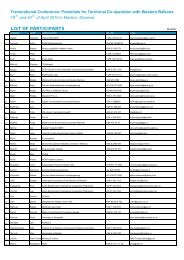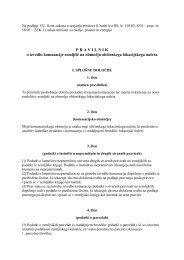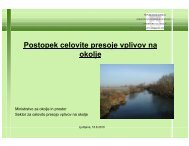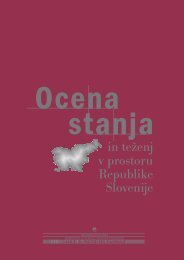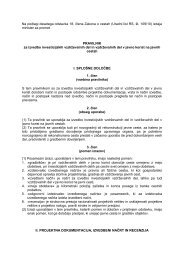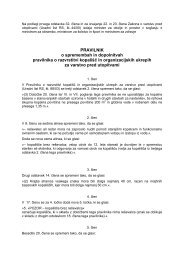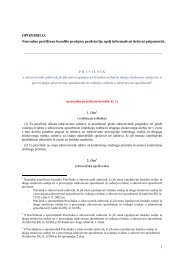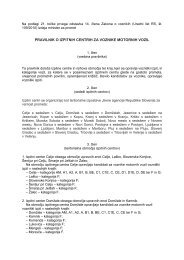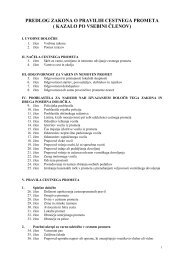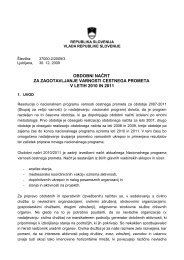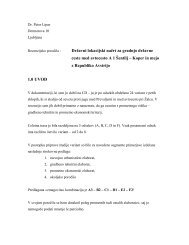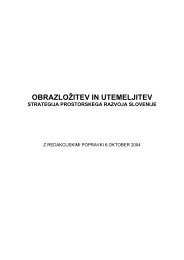evropska konvencija o krajini - Ministrstvo za infrastrukturo in prostor
evropska konvencija o krajini - Ministrstvo za infrastrukturo in prostor
evropska konvencija o krajini - Ministrstvo za infrastrukturo in prostor
You also want an ePaper? Increase the reach of your titles
YUMPU automatically turns print PDFs into web optimized ePapers that Google loves.
232Delavnica 3 / Workshop 3prepoznavna <strong>in</strong> istovrstna, da jih je mogočetopografsko <strong>in</strong> kulturno def<strong>in</strong>irati. Stavbnadedišč<strong>in</strong>a <strong>in</strong> kulturna kraj<strong>in</strong>a ter vse druge<strong>prostor</strong>ske prv<strong>in</strong>e morajo biti pretežno ohranjeneoziroma nemoteče. Zaradi medsebojnihrazmerij kulturnih prv<strong>in</strong> <strong>in</strong> velikosti imajoobmočja dodatno kulturno, družbeno <strong>in</strong>gospodarsko vrednost.Elementi, vseb<strong>in</strong>e <strong>in</strong> značilnosti, ki se zlastivarujejo, so:– enotnost <strong>in</strong> pove<strong>za</strong>nost <strong>prostor</strong>a, kakor tudidrugih kulturnih, zgodov<strong>in</strong>skih, socialnihvseb<strong>in</strong>, ki jih družba prepozna kot posebnevrednote,– značilnosti <strong>in</strong> posebnosti morfološke zgradbe,– nač<strong>in</strong> pove<strong>za</strong>ve kulturne kraj<strong>in</strong>e s stavbno <strong>in</strong>naselb<strong>in</strong>sko dedišč<strong>in</strong>o,– tradicionalni vzorci poselitve, temeljne značilnostiparcelne strukture <strong>in</strong> <strong>prostor</strong>skarazmerja,– zgodov<strong>in</strong>ske smeri v <strong>prostor</strong>u.Za ta območja bi morali <strong>za</strong>radi <strong>za</strong>htevnosti <strong>in</strong>celovitosti problematike pripravljati kraj<strong>in</strong>ske<strong>za</strong>snove ali kraj<strong>in</strong>sko razvojne načrte (poZUreP-1, 60. člen), v okviru katerih se na podlagipodatkov <strong>in</strong> vrednostnih ocen o dedišč<strong>in</strong>i terdrugih, <strong>za</strong> določeno območje pomembnihpodatkov, izdelajo analize stanja <strong>in</strong> razvojnihmožnosti, opredeli kraj<strong>in</strong>ske prv<strong>in</strong>e, ki se zlastivarujejo, <strong>in</strong> opredeli usmeritve <strong>za</strong> nadaljnji<strong>prostor</strong>ski razvoj. Z <strong>in</strong>terdiscipl<strong>in</strong>arnostjopristopa je potrebno <strong>za</strong>gotoviti širšo vpetostvarstva <strong>in</strong> razvoja kulturne dedišč<strong>in</strong>e v razvojneprograme. Izkazuje se, da je ob pomanjkanjudirektnih f<strong>in</strong>ančnih spodbud ohranjanjededišč<strong>in</strong>skih kulturnih kraj<strong>in</strong> še najbolj uč<strong>in</strong>kovitopreko sistema urejanja <strong>prostor</strong>a oz. razreševanjaproblematičnih <strong>prostor</strong>skih situacij zmetodami <strong>prostor</strong>skega načrtovanja.tection regime, and use it <strong>in</strong> such a way thatits cultural function is consistently taken <strong>in</strong>toaccount. The owner is entitled to compensationif the protection regime adversely affectsconditions for the commercial exploitation ofthe monument and this cannot be substitutedby another activity with<strong>in</strong> the frameworkof the protection regime. If ma<strong>in</strong>tenanceor <strong>in</strong>terventions necessary to protector restore the monument require extraord<strong>in</strong>arycosts which exceed the economic benefitand the usual costs of ma<strong>in</strong>tenance, thestate or local community may contributepublic funds to this end.3. Areas of national recognisability from thepo<strong>in</strong>t of view of the cultural and symbolicimportance of the landscapeIn the last decade, the category of ‘areas ofcomplex heritage conservation <strong>in</strong> openspace’ has become quite well established onthe basis of a variety of expert material. Areasof complex heritage conservation <strong>in</strong>open space is a category with<strong>in</strong> the conservationof cultural heritage and also the culturallandscape based on a comprehensiveapproach to the def<strong>in</strong>ition and conservationof cultural heritage <strong>in</strong> open space which also<strong>in</strong>cludes landscape areas. With the adoptionof Spatial Development Strategy of Slovenia,the areas were <strong>in</strong>corporated <strong>in</strong>to spatial developmentguidel<strong>in</strong>es at the national level as‘areas with recognised characteristics whichare important at the national level because ofthe cultural and symbolic importance of thelandscape’, also known as ‘landscape areasof national recognisability because of culturaland symbolic importance’.These are relatively large spatial units conta<strong>in</strong><strong>in</strong>gone or more smaller areas with a spatially, substantially,or functionally <strong>in</strong>terconnected culturalheritage and an <strong>in</strong>termediate space with <strong>in</strong>dividualvaluable cultural elements which guaranteethe smaller areas their spatial <strong>in</strong>tegrity andenrich them with the cultural values present.Taken as a whole, the areas are sufficiently recognisableand uniform to allow their topographicaland cultural def<strong>in</strong>ition. The architectural heritageand cultural landscape and all the otherspatial elements must be largely extant or non<strong>in</strong>trusive.Thanks to the reciprocal relationshipsof cultural elements and because of their size,these areas have extra cultural, social and commercialvalue.



